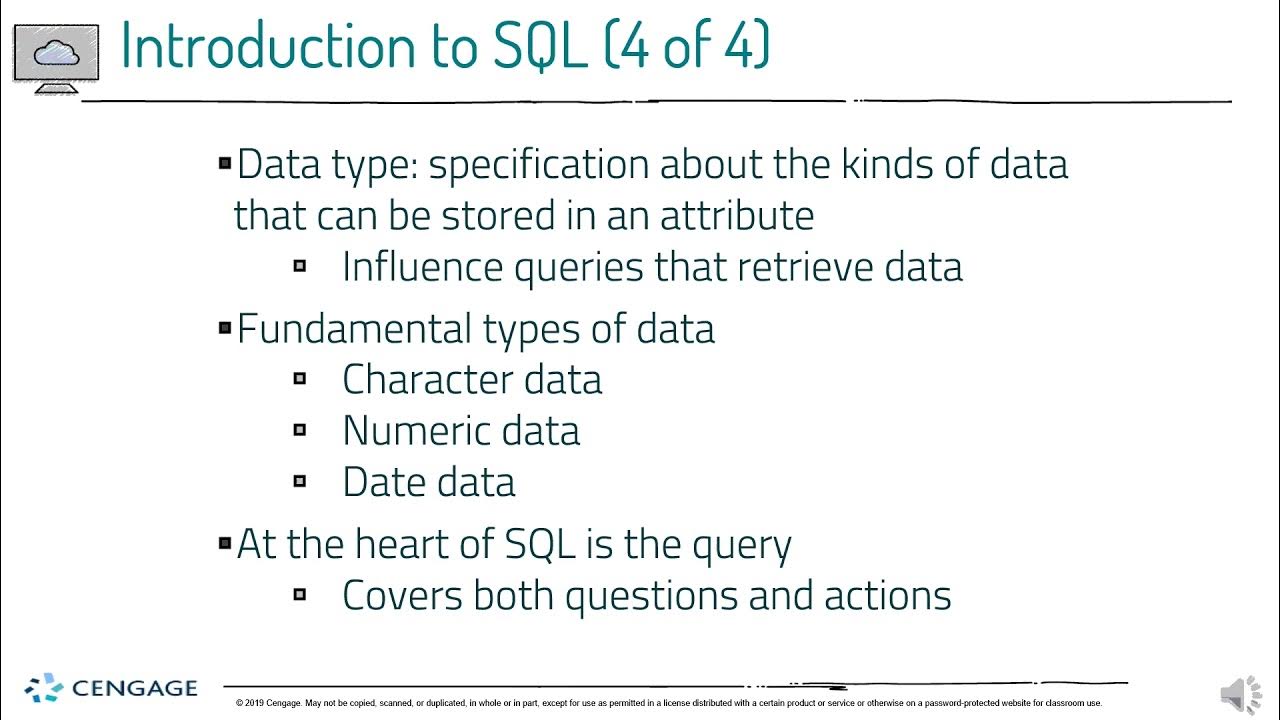Introduction to Functions Part 1
Summary
TLDRThis lesson introduces SQL functions, which are powerful tools for manipulating and transforming data. The video explains two main types: single row functions (like case conversion and string manipulation) and multiple row functions (such as aggregation and calculations). It provides examples of how to use these functions to modify data formats, calculate values, and search for specific data patterns. The lesson also covers essential character functions like CONCAT, SUBSTRING, and LENGTH, and explains how to apply functions to tables using a dual table for testing. The goal is to help users understand how to use SQL functions effectively to process and display data.
Takeaways
- 😀 Functions in SQL are powerful tools used to transform input data into different output forms, enabling data manipulation and display customization.
- 😀 There are two types of SQL functions: Single row functions and multiple row functions. Single row functions operate on individual rows, while multiple row functions operate on groups of rows and return a single value.
- 😀 Single row functions manipulate individual data items and return a result for each row processed. They can also modify data types and be nested.
- 😀 Multiple row functions are used to process groups of rows and return a single value, with examples like MAX, MIN, and AVG for calculating the highest, lowest, and average values in a group.
- 😀 Character functions in SQL include case conversion functions (e.g., LOWER, UPPER) and manipulation functions (e.g., CONCAT, SUBSTRING, REPLACE). These help in formatting and modifying string data.
- 😀 The `LOWER()` and `UPPER()` functions in SQL are useful for case-insensitive searches by converting all text to a uniform case, either lowercase or uppercase.
- 😀 The `INITCAP()` function capitalizes the first letter of each word in a string, useful for formatting names or titles.
- 😀 The `CONCAT()` function joins two strings together. It can be used to combine multiple pieces of data, like first and last names, into one string.
- 😀 The `SUBSTRING()` function extracts a portion of a string, starting from a given position and with a specified length. It can be used to search for strings with specific patterns or characters.
- 😀 Other useful character functions include `LENGTH()` to get the number of characters in a string, `INSTR()` to find the position of a character in a string, and `REPLACE()` to replace part of a string with another.
- 😀 The `DUAL` table in SQL is commonly used for testing functions when no specific table data is involved. It's a dummy table used in queries where the result is not tied to any database table.
Q & A
What is the primary purpose of functions in SQL?
-The primary purpose of functions in SQL is to transform input into output. Functions manipulate data values by performing operations on values or columns and returning a different output.
What are the two main types of functions in SQL?
-The two main types of functions in SQL are single-row functions and multiple-row (or group) functions. Single-row functions process one row at a time, while multiple-row functions process many rows and return a single value.
What is the difference between single-row functions and multiple-row functions in SQL?
-Single-row functions accept one or more arguments and return a single result per row, whereas multiple-row functions operate on many rows as input and return a single value as output.
What is the role of the 'dual' table in SQL?
-The 'dual' table in SQL is used as a dummy table for testing functions or running queries that do not require data from any specific database table. It is typically used when functions need to be tested independently.
What does the 'lower' function in SQL do?
-The 'lower' function in SQL converts all characters in a string to lowercase, which is useful for ensuring case-insensitive searches or formatting data for display.
How can you use the 'upper' function in SQL?
-The 'upper' function in SQL converts all characters in a string to uppercase, which is commonly used for case-insensitive searches or when you need to standardize the format of data.
What is the 'initcap' function used for in SQL?
-The 'initcap' function in SQL capitalizes the first letter of each word in a string, while leaving the rest of the letters in lowercase. It's useful for formatting names or titles properly.
What does the 'concat' function do in SQL?
-The 'concat' function in SQL is used to join two or more strings together into one. It concatenates character string arguments, such as joining a first name and a last name.
What is the purpose of the 'substring' function in SQL?
-The 'substring' function in SQL extracts a portion of a string, starting at a specified position and optionally with a specified length. It's used to isolate parts of strings based on position.
How does the 'length' function work in SQL?
-The 'length' function in SQL returns the number of characters in a given string. It can be useful for checking the size of data fields, such as last names or addresses.
Outlines

هذا القسم متوفر فقط للمشتركين. يرجى الترقية للوصول إلى هذه الميزة.
قم بالترقية الآنMindmap

هذا القسم متوفر فقط للمشتركين. يرجى الترقية للوصول إلى هذه الميزة.
قم بالترقية الآنKeywords

هذا القسم متوفر فقط للمشتركين. يرجى الترقية للوصول إلى هذه الميزة.
قم بالترقية الآنHighlights

هذا القسم متوفر فقط للمشتركين. يرجى الترقية للوصول إلى هذه الميزة.
قم بالترقية الآنTranscripts

هذا القسم متوفر فقط للمشتركين. يرجى الترقية للوصول إلى هذه الميزة.
قم بالترقية الآنتصفح المزيد من مقاطع الفيديو ذات الصلة

07 Introduction to SQL PART1

SQL Basics for Beginners | Learn SQL | SQL Tutorial for Beginners | Edureka

Belajar Oracle PL/SQL, Mengenal Berbagai Jenis Single Row Function #1

Dataframes - Part 01

DP-900 Exam EP 03: Data Job Roles and Responsibilities

SQL from basic to Advanced | Types of Commands in SQL - Day - 2
5.0 / 5 (0 votes)
